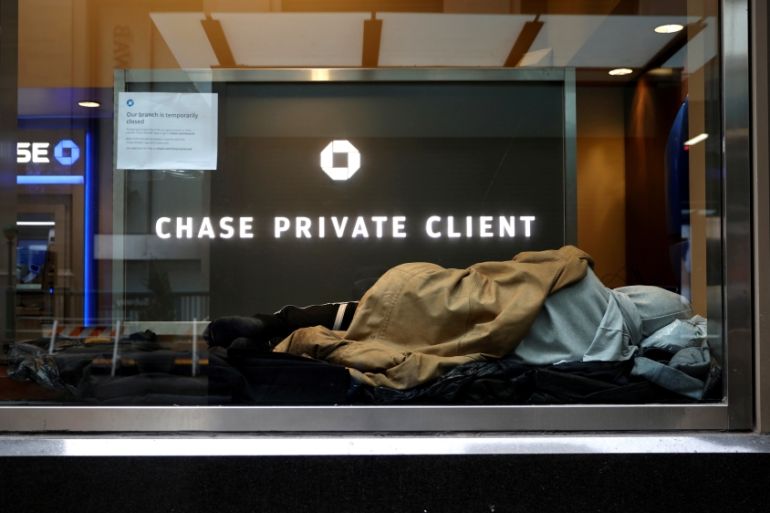Dow surges almost 900 points on slowing coronavirus cases
Wall Street extends Monday’s rally as governors of NY and NJ say there are tentative signs virus curve is ‘flattening’.

United States stocks surged again on Tuesday extending Monday’s rally on hopes that the coronavirus crisis is plateauing, while energy stocks climbed on Exxon Mobil belt-tightening and mounting hopes for a ceasefire in the oil price war between Saudi Arabia and Russia.
The Dow Jones Industrial Average soared 887.61 points or 3.91 percent to 23,567.60 in the early minutes of trading in New York. The S&P 500 index- a gauge for the performance of US retirement and college savings plans – jumped 3.34 percent higher while the Nasdaq Composite Index traded 2.77 percent higher.
Keep reading
list of 3 itemsOil prices plunge after OPEC+ talks break down
Virus sinks US labour market with 700,000 jobs lost in March
By midmorning, all three US stock indexes gave back roughly half of their opening gains but were still firmly in positive territory.
Tuesday’s gains built on Monday’s historic rally that saw all three major indexes jump more than 7 percent as the governors of New York and New Jersey said their states were showing preliminary signs of a “flattening” of new virus cases.
Louisiana Governor John Bel Edwards said later on Monday that new hospital admissions were trending down in his state – also among the hardest hit in the US.
Still, the trend is far from certain, as is the outlook for how quickly the US economy can bounce back from coronavirus disruptions.
“The outlook for the broad market going forward really depends more on the recovery and the ability of the Fed and other policymakers to keep banks healthy,” Steven Ricchiuto, chief US economist at Mizuho Securities wrote in a note to clients. “So, assuming we begin to unwind the lockdown by early-May, we look for the equity market to have made up most if not all of its losses by this time in 2021.”
Goldman Sachs analysts are warning that a wave of bankruptcies might lead firms to stop paying their bills, causing a ripple effect of missed payments that could undermine confidence in ordinary business transactions.
“One way that the coronacrisis could have long-lasting scarring effects is by sparking a wave of bankruptcies as revenues plummet in many industries,” Goldman wrote in a report on Tuesday.
“During the last recession, a spike in firm closures and a dip in new firm openings left a ‘lost generation’ of firms that slowed the recovery,” Goldman added.
Despite Monday’s bounce, the S&P 500 remains more than 21 percent below its mid-February record high, and investors are concerned that more production cuts and staff furloughs could be on the horizon as stay-at-home orders remain in effect.
Energy stocks climbed on Tuesday as hopes mounted for a truce in the oil price war between Saudi Arabia and Russia and Exxon Mobil throttled back a multi-year investment spree in shale and liquified natural gas (LNG) and deep-water oil production.
Exxon Mobil announced it would cut planned capital spending this year by 30 percent as the pandemic saps energy demand.
And oilfield services firm Halliburton Co said it would cut about 350 jobs in Oklahoma and that its executives would reduce their salaries.
Exxon and Halliburton shares jumped 5.4 percent and 6.3 percent, respectively in early trading in New York.
Some analysts though think that the bout of optimism surrounding energy shares underestimates the severity of the oversupply problem coming in April and May.
“With 28 million bpd [barrels per day] oversupply in the oil market in April and 21 million bpd in May, the global coordinated production cuts that are really needed may be too large for the producers to accept, perhaps twice as large as the numbers that are currently being discussed,” Bjornar Tonhaugen, head of Oil Markets at Rystad Energy, said.
Tonhaugen warned that the onshore storage for refined oil products may run out during mid-April, forcing even deeper run cuts, which will then cascade into the largest upstream production shut-ins in history.
Worldwide, COVID-19 has infected at least 1.3 million people and killed over 76,000, according to Johns Hopkins University. Though the numbers are still rising in many highly populated countries, there are tentative signs the pandemic is slowing in parts of Europe and the US.